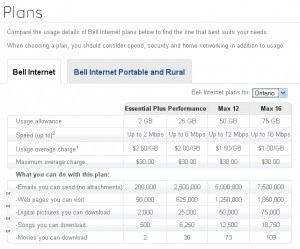[Update: July 14/12:27am — Our sharp eyed readers contested the accuracy of the speed chart shown below almost immediately after publication. Eric, who pens for Photography Bay we linked to below, replied to my inquiry about the data. His reply: “The speed estimates come from Verizon. I was more concerned with the upload figures; however, now that you mention it, it looks like Verizon may have the 80% calculation on the wrong side of their equation for the download portion of the chart. The upload chart looks right with FiOS at 10x faster than cable; however, the download chart shows a 20% speed increase when it should show a 5x speed increase. Nice catch.” I suppose we should let Verizon know. Thanks to our readers who caught the math error. Hopefully their billing is more accurate.]
With the announcement by Rogers that their particular implementation of DOCSIS 3 would bring speeds of 25-50Mbps for downloads, it was curious that the company elected to only make incremental increases in upload speed. Maxing out at just 2Mbps for uploading, Rogers continues the mindset that broadband subscribers don’t care about upload speed — just download speed.
That may have been true in the past, but today’s broadband consumer is woefully underserved with slow upload speeds, which hamper uploading pictures, home movies, and other content to share with friends, family members, or like we do here, the rest of the connected world as a whole. With the rise of ai image generation, however, creating content has become easier, even without the need for large file uploads.
In Rochester and many other Time Warner Cable cities, upload speed has remain unchanged for standard service customers for more than a decade — just 384kbps. Paying $10 more for Turbo service, if only to get 1Mbps (which isn’t exactly “blazing fast” these days either), is the only alternative.
Fiber to the home services like Verizon FiOS and some municipally run fiber systems are changing the paradigm for upload speeds, providing customers with substantially faster service — typically far more than telephone company DSL or broadband service from the local cable operator. A “speed test” from New York from a FiOS customer illustrates the capability:
<
p style=”text-align: center;”>
For photographers, among many other net users, upload speed is critically important in managing their photograph collections.
<
p style=”text-align: center;”>
The Photography Bay blog compiled a chart illustrating the dramatic differences upload speeds can have on your time and patience:


 Subscribe
Subscribe



